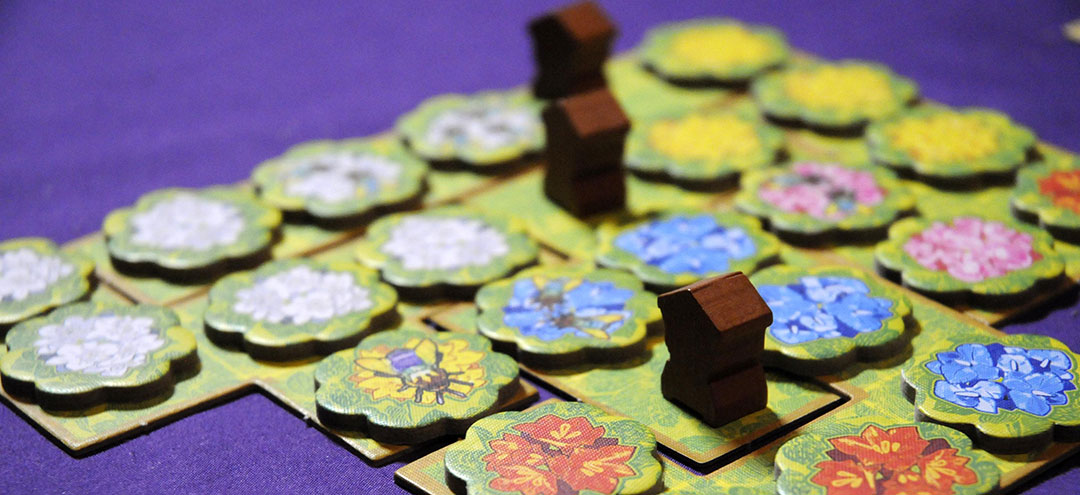 Gosh, I really don’t like bees. I get their purpose in the ultimate balance of the universe, but bees in the real world scare me. Bees in Queenz though? They’re powerful point farmers and I want them all! Paired with the beauty of the orchids in the garden, this game easily attracted me from the shelf.
Gosh, I really don’t like bees. I get their purpose in the ultimate balance of the universe, but bees in the real world scare me. Bees in Queenz though? They’re powerful point farmers and I want them all! Paired with the beauty of the orchids in the garden, this game easily attracted me from the shelf.
Queenz: To Bee or Not to Bee is a pattern building game for 2 to 4 players that takes about 30 minutes to play. The best experience is with 3 players for the game to feel more about pattern building than it is about positioning around your opponents.
Gameplay Overview:
After setting up the secret orchid draw pile, main community garden, field tiles, diversified production point tokens, and the Gardener, everyone is ready to start! You have two options on your turn: 1) add new orchid tokens to your supply or 2) fill one field tile with orchid tokens and/or hives you have in your supply.
The number of tokens you can take and add to your supply depends on several factors: where the Gardener meeple is in the community Garden, how many orchids you want to take, and what types of orchids they are. The Gardener meeple then steps around the edges of the community Garden based on how many orchid tiles were taken, which then changes the options for the other players.
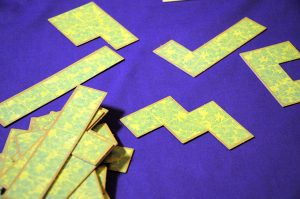
But, if you’re choosing to fill a field tile, that tile will come from the public market and must be filled entirely by orchids and/or hives. No empty spaces! Then, you’ll score honey points in-game based on the creation or enlargement of orchid tokens of the same type(s). The honey pot tokens in front of your player area are used to signify when you have produced honey of that color for the first time. Producing honey requires a minimum of two orchid tokens of the same color next to each other in the fields.
Some of these tiles, as I mentioned earlier, have a Queen bee or clusters of normal bees on them. A Queen bee, or single bee, tile can be used to swap one orchid tile from your field with the Queen bee from your supply. This is only helpful for preparing large clusters of orchids for scoring later, and not for scoring at the moment this ability is performed.
As players begin to fill fields, the market choices diminish, and the community garden looks emptier. The market does not replenish until a player has taken the last available field or certain movement conditions happen with the Gardener. With that, there is some amount of strategy around moving the Gardener and the timing of filling fields.
The end of the game is triggered by any one player filling and placing (or “blooming” as the game calls it) their fifth field. This is where hives come in; they score points equal to the number of bees orthogonally and diagonally adjacent to it. Ideally, throughout the game and building out your field you’ve been surrounding your hives with orchids that have bee friends and you’ll have both the in-game scoring of matching orchids and the end-game scoring of having lots of bees surround your hives.
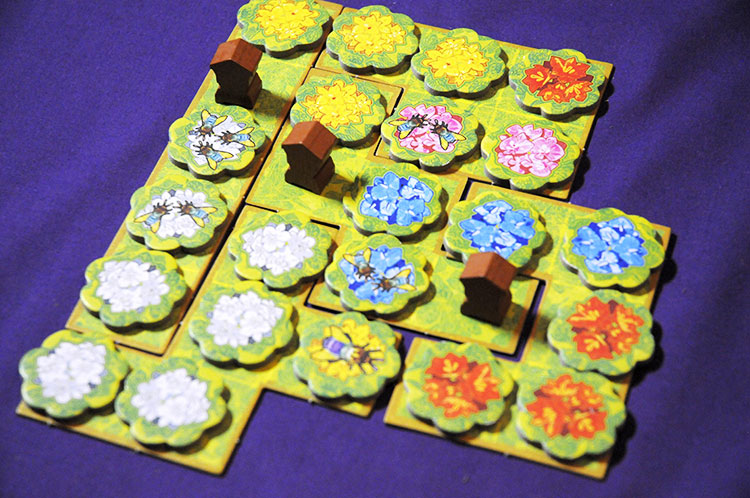
Game Experience:
It’s fun to have to think about the wrap around and the configuration of the garden at the same time as planning out your field. I enjoy the difficulty of anticipating the priorities of opponents because both the in-game and end-game scoring is favorable. The orchid tile and field tile denial problems are rampant because orchids can be different colors and/or have bees, while field tiles have different shapes and consequently possibilities of belonging to your existing field. There are quite a few orchids and I could imagine that if orchid tiles with bees come out much later it would create a completely different gaming experience, so the variable setup is always a great feature.
At a minimum, planning around the perspective changes around the garden without any interaction with other players is already tough and fun. First, you’re only thinking of timing for columns and then suddenly the Gardener turns a corner and you’re worried about rows!
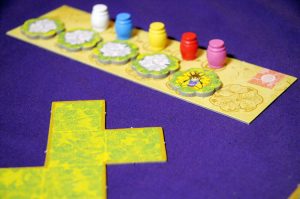
Once you move into the state of your supply where you can populate fields, there’s a little bit of now or never on the hive placement. You don’t always get a choice on what tiles you get since you do this on your turn yet you don’t want to miss out on possibly getting points for diversified production simply because you’re holding out on for more bees. Balancing priorities in this way is much appreciated.
When I have no idea what to do on my turn in games, I sometimes just grab resources for future turns, but in Queenz you are limited on how many orchids you can store in your supply. This does help in pushing you to spend your next turn filling up a field, so logically the game forces you to make a strategy even if you don’t want to or have one.
As for scoring on diversified tokens, since you can at least get some points from them regardless of making it first, it may make sense to hold off on trying to win that race and instead create lucrative fields and try and build around hives. You only get three hives, so they definitely need to be taken seriously. That being said there’s no indication that you are required to use the hives so you could just focus on the in-game if you liked, but in my experience, during gameplay, it gave the edge on the win. Anyone who ignored them regretted it later.
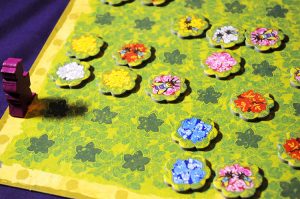
Overall, it’s a much more interesting puzzle than other tile-laying or pattern-building games I’ve played because of the Gardener movement. It’s not just about take and place a tile, it’s about taking orchids, taking tiles that may or may not work now, building around and finally hoping that you have good timing on hive placement as it takes a spot from one of the orchids.
The only things unclear to me in the game were thematic in nature, with regards to why we share a gardener and why this gardener has so much power over us, why we would want diverse fields that may not set us up for raging success in any one orchid type, and why a queen bee would be a way to uproot orchids we’ve planted before. Everything else I noted before is more an exploration of the game’s oddities with more experience than a formal complaint.
Final Thoughts:
Queenz will get you to like bees, as bees are your end-game scoring friends that will give you the edge in your field of orchids. Navigating around the timing of the Gardener, what orchid tiles are available to you and the shape within which your field grows are all important, fun puzzles in this game. It encourages you to also respect your environment, to have a clear strategy and not hoard unnecessarily. You’ll be forced to produce honey and grow your fields, whether you like it or not. For a game with pleasant art and bright pop colors, the future may not be as bright if you underestimate its complexity.
Final Score: 4 Stars – Orchids to fill your growing fields are controlled by the dynamic Gardener in this pattern-building game featuring bees as point generators.
 Hits:
Hits:
• Multidimensional timing and scoring
• Variable setup keeps it fresh
• No hoarding is allowed
Misses:
• No reasons we share a gardener
• Arbitrary points given for diversification
• Unclear why the queen manipulates orchids







